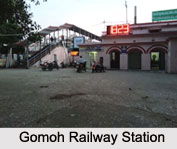 Gomoh is a small settlement in Dhanbad district of Jharkhand. Dhanbad, the district headquarters is located in the northwest of Gomoh at a distance of 43 km. Ranchi, the state capital is located in the southwest of Gomoh at a distance of 110 km. The town is well connected to other places in the state. The nearest airport is at Ranchi and the nearest railhead is the Gomoh Junction Railway Station. It is located between 23.87° North latitude and 86.17° East longitude at a height of 245 metres (803 feet) above mean sea level.
Gomoh is a small settlement in Dhanbad district of Jharkhand. Dhanbad, the district headquarters is located in the northwest of Gomoh at a distance of 43 km. Ranchi, the state capital is located in the southwest of Gomoh at a distance of 110 km. The town is well connected to other places in the state. The nearest airport is at Ranchi and the nearest railhead is the Gomoh Junction Railway Station. It is located between 23.87° North latitude and 86.17° East longitude at a height of 245 metres (803 feet) above mean sea level.
As per the 2001 India census report, Gomoh had a population of 28, 576. Males constitute 54% of the population and females constitute 46% of the population. In Gomoh, 15% of the population is less than six years of age. The average literacy rate of this town is 70% which is higher than the national average literacy rate of 59.5%. The male literacy rate is 78% and the female literacy rate is 60%.
Topchanchi, a tourist destination, is 5 km north of Gomoh. Nawadih, Dumdumi, Dugda and Tundua are the surrounding places.



















